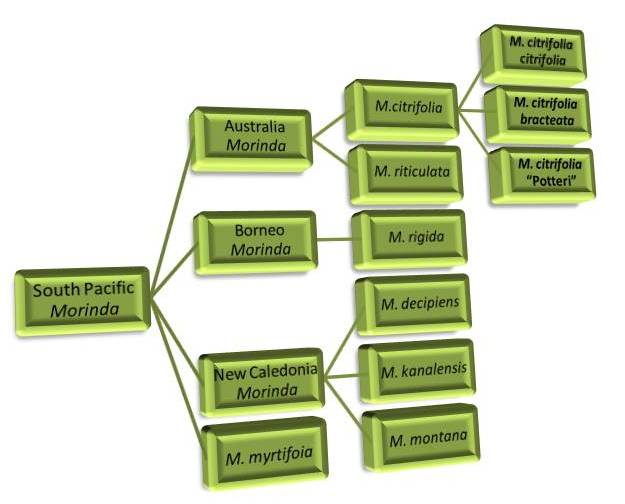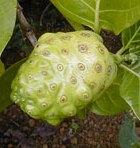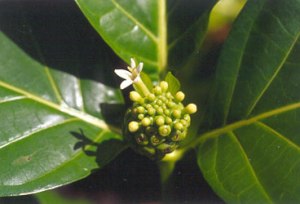Habitat and Adaptation
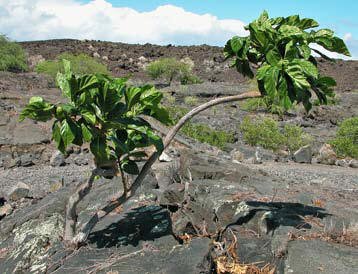
This is a very hot, dry, and windy environment, and
this Noni tree is thriving in this crack of a lava
rock.
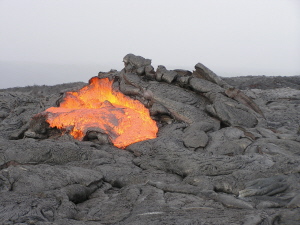 Morinda citrifolia, or noni, is native to
Indonesia, Australia and is found throughout the
tropics in a wide variety of environments. The noni
is considered an invasive species, but not to the
degree that is threatens ecosystems. Even though in some
locations it is considered a weed.
Morinda citrifolia, or noni, is native to
Indonesia, Australia and is found throughout the
tropics in a wide variety of environments. The noni
is considered an invasive species, but not to the
degree that is threatens ecosystems. Even though in some
locations it is considered a weed.
This species can tolerate very acidic, infertile, alkaline
soil, and is a very persistent, hard to kill plant
that has a high tolerance for wind, fire, flooding
and salt. It can withstand drought for six months or
more. Wild noni can grow in very arid conditions and
spend their in entire lives in perpetual drought.
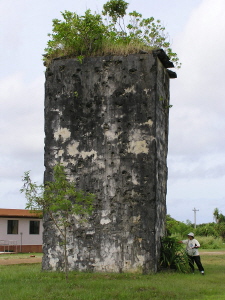 Noni can also withstand flooding for long periods of
time. Seawater, even with the high levels of salinity,
is thought to be beneficial to the noni due to the
minerals the seawater contains. Noni have been found
in many harsh environments and soil conditions, such
as basaltic lava flows, coral atolls, solution pits,
or brackish tide pools; Noni are usually one of the
first plants to colonize these harsh and unfavorable
environments.
Noni can also withstand flooding for long periods of
time. Seawater, even with the high levels of salinity,
is thought to be beneficial to the noni due to the
minerals the seawater contains. Noni have been found
in many harsh environments and soil conditions, such
as basaltic lava flows, coral atolls, solution pits,
or brackish tide pools; Noni are usually one of the
first plants to colonize these harsh and unfavorable
environments.
Because noni are found across such a large range, it is probably that noni seeds are spread around by water, birds, and fruit bats. Not to mention noni can be found in rather odd locations. For example, a noni tree was found on the top of an old Japanese communications tower on the Micronesian Islands from WWII.
Nonis are associated with a wide variety of coastal vegetation, such as bananas, Musa genus; papaya, Carica papaya; palm trees; coconuts, Cocos nucifera, and betel nut palms, Areca catechu; hibiscus, Hibiscus genus; and many others.
Morinda Adaptation
Noni from different places have different characteristics, and even though M. citrifolia is grouped with the species from Aulstralia, it's actually very widespread. Morinda citrifolia is closely related to Morinda reticulata, also known as the Mapoon Bush. Although it tastes delicious, M. reticulata can absorb high amounts of selenium and can be poisonous to animals and humans that consume it.
Morinda citrifolia seems to be closely related to species restricted to Australia and Borneo which may indicate that M. citrifolia may have evolved in Australia or Borneo and was distributed via ocean currents or birds. Morinda citrifolia seems to have adapted the ability to colonize new islands and terrain, such as lava flows. Because they can colonize new terrain relatively quickly it is suspected that they can self-pollinate. It is hypothesized that this self pollinating means that M. citrifoia is just a long line of individuals that accumulated mutational changes as they moved from island to island. So variation within the species represents individual variation instead of species variation. (To learn more Click Here)
Three Intra-species of Morinda citrifolia
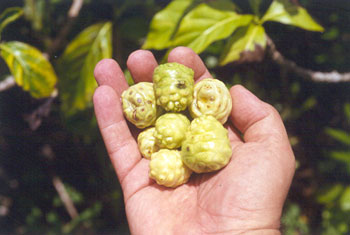
Morinda citrifolia var. citrifolia is the most
abundant in the Pacific region and most used for
medicinal purposes. This is a morphological
diversity group with no unique distinctiveness to
any of these sub-species. This sub-species has both
large fruit with oval leaves and small fruit with
elongated leaves.
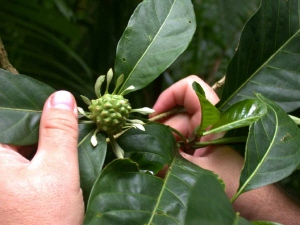
Morinda citrifolia var.
bracteata is a small-fruited
variety most commonly found in Indonesia and India.
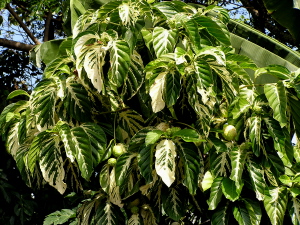
Morinda citrifolia var. "Potteri" is more of an
ornamental plant that agricultural. With green and
white leaves and a dry fruit, this subspecies is
more decorative.
